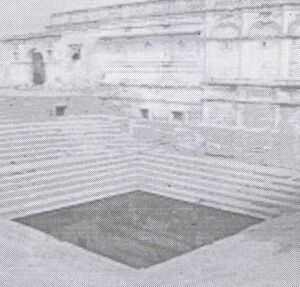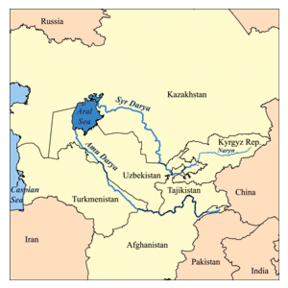Karkala
- For the place name see Karak Pakistan
Karkala (करकला) Jat gotra people[1] live in Bharatpur district in Rajasthan.
Origin
They are said to have originated from Nagavanshi King Krikalasa (कृकलास). Kerk, Kruk, Kurk, Karak is a tribe mentioned by Sir H. M. Elliot[2] living in Sindh. This seem to be a variant of Jat clan Karkala.
Jat Gotras Namesake
- Caracalla[3] (born Lucius Septimius Bassianus, 4 April 188 – 8 April 217 AD) was the nickname of Marcus Aurelius Antoninus who was Roman emperor from 198 to 217. Caracalla was a member of the Severan dynasty. He had a slightly younger brother, Geta, with whom Caracalla briefly ruled as co-emperor.[4]
Jat Gotras Namesake
Villages in Bharatpur district
History
Hijra 151. A.D. 768. : In this year the Kurks made an attack upon Jidda.[6]
Karkalonger village
करकलांगर (जाट गोत्र - करकला) : करकलांगर नाम का गाँव झारखंड के पश्चिमी सिंहभूम जिले की बंदगांव विकास-खंड में है।
Raja Karka
Alexander Cunningham[7] while describing Balabhi mentions of Karka Raja of Lateshwara.
[p.317]: The ruins of the famous city of Balabhi were dis-covered by Tod near Bhaonagar, on the eastern side of the peninsula of Gujarat. In an inscription of the fifth century the country is called " the beautiful kingdom of Valabhadra,"[8] but in the local histories and traditions of the people, it is generally known as Balabhi. This also was the name in the time of Hwen Thsang, who calls the kingdom Fa-la-pi, or Balabhi. In ancient times, however, the peninsula of Gujarat was only known as Surashtra, and under this name it is mentioned in the Mahabharata and in the Puranas. It is called Surashtrene by Ptolemy and the author of the ' Periplus ;' and its people are most probably intended by Pliny under the corrupt name of Suarataratae, or Varetatae, for which I would propose to read Suratae.
The change in the name of the country is alluded to in an inscription, dated in the Saka year 734, or A.D. 812, of Raja Karka, whose remote ancestor Govinda is said to have been the ornament of the Saurashtra kingdom, " which lost its appellation of Sau-rajya from the ruin that had fallen upon it."[9] Karka's father is called Raja of Lateswara, which at once identifies his kingdom with Balabhi, as Hwen Thsang notes that Balabhi was also called Pe-Lo-lo, or northern Lara, which is the common pronunciation of the Sanskrit Lata. As Karka was only the fifth in descent from Govinda, the name of Saurajya or Saurashtra could not have been restored by these representatives of the old family before the middle of the seventh century. From a comparison of all the data I conclude that the old name of Saurashtra was lost in A.D. 319, when the successors of the Sah kings were sup-
[p.318]: planted by the Vallabhas, and the capital changed from Junagarh to Valabhi. The establishment of the Balabhi era, which dates from A.D. 319, is said by Abu Rihan to mark the period of the extinction of the Gupta race, whose coins are found in considerable numbers in Gujarat. This date may therefore be accepted with some certainty as that of the establishment of the Balabhi dynasty, and most probably also as that of the foundation of their city of Balabhi.
According to the native histories and local traditions Balabhi was attacked and destroyed in the Samvat year 580, which is equivalent to A.D. 523, if in the Vikrama era, or A.D. 658, if in the Saka era. Colonel Tod has adopted the former; but as Hwen Thsang visited Balabhi in A.D. 640, the date must clearly be referred to the later era of Saka. If the statement is correct, we may refer the capture of Balabhi to Raja Govinda of the Baroda copper-plate inscription, who is recorded to have re-established the old family, as well as the old name of the former kingdom of Saurashtra. As he was the great-grandfather of the grandfather of Karka Raja, who was reigning in A.D. 812, his own accession must have taken place in the third quarter of the seventh century, that is, between A.D. 650 and 675, which agrees with the actual date of A.D. 658, assigned by the native historians for the destruction of Balabhi, and the extinction of the Balabhi sovereignty in the peninsula of Gujarat.
कृकलास कुण्ड

कृकलास कुण्ड - द्वारका के तीर्थों में कृकलास कुण्ड प्राचीन एवं ऐतिहासिक स्थान है। इस स्थान का महात्म्य श्रीमद भागवत और सकंदपुराण के राजा नृग के आख्यान के साथ जुड़ा हुआ है। [10] कृकलास एक नागवंशी राजा थे। नृग भी जाट गोत्रों की सूचि में पाया जाता है परन्तु इसका विस्तार नहीं है। करकला जाट गोत्र भरतपुर में पाया जाता है।
कहते हैं कि राजा नृग प्रतिदिन एक हजार गाय ब्राह्मणों को दान किया करता था। एक दिन भूलवश दान की हुई गाय दुबारा ब्राह्मण को दान कर दिया तो ब्राह्मण ने राजा को शापित किया कि वह गिरगिट की योनि प्राप्त करेगा। उसका उद्धार भगवान् कृष्ण के स्पर्श हुआ। वह कूप कृकलास तीर्थ के नाम से विख्यात है। कृकलासमिति ख्यातं नृगतीर्थमनुत्तम् नृगो यत्र महिपालः कृकलासवपुर्द्धर - स्कन्द पुराण द्वारका माहात्म्य अ. [11]
In Lake Urmia
Lake Urmia (Persian: دریاچه ارومیه) is a salt lake in northwestern Iran between the provinces of East Azarbaijan and West Azarbaijan, west of the southern portion of the similarly shaped Caspian Sea. Lake Urmia has 102 islands. Karkas name appears for one of the names of the lakes in this list. The current Indian names of the places and Jat clan name indicates their ancient linkage with Iran.
Aral Sea

The Aral Sea (Kazakh: Арал Теңізі, Aral Tengizi, Uzbek: Orol dengizi, Russian: Аральскοе мοре), Tajik/Persian "Daryocha-i Khorazm" (Lake Khwarazm) (Khor, Khoja Jat clans) is a landlocked endorheic basin in Central Asia; it lies between Kazakhstan in the north and Karakalpakstan (Karkala Jat clan), an autonomous region of Uzbekistan, in the south. The name roughly translates as "Sea of Islands", referring to more than 1,500 islands of one hectare or more that dotted its waters.
Karakala village in Udaipur District
Karakala village is in Girwa tahsil in in Udaipur District in Rajasthan.
Notable persons
External links
The_History_of_India,_as_Told_by_Its_Own_Historians/Note_(C).-_Ethnological#The_Kerks
See also
References
- ↑ डॉ पेमाराम:राजस्थान के जाटों का इतिहास, 2010, पृ.298
- ↑ The History of India, as Told by Its Own Historians/Note (C).- Ethnological,pp.508-511
- ↑ "Caracalla". The American Heritage Dictionary of the English Language (5th ed.). HarperCollins.
- ↑ Gagarin, Michael (2009). Ancient Greece and Rome. Oxford University Press. p. 51.
- ↑ Bhim Singh Dahiya:Jats the Ancient Rulers (A clan study)/Porus and the Mauryas, p.168,s.n.41
- ↑ The history of India : as told by its own historians. Volume II/VI. Kamilu-t Tawarikh of Ibn Asir, by Sir H. M. Elliot Edited by John Dowson, 1867, p. 246
- ↑ The Ancient Geography of India/Gurjjara, p.316-318]
- ↑ Journ. Asiat. Soc. Bengal, 1838, p. 976.
- ↑ Ibid., 1839, p. 300. Inscription from Baroda.
- ↑ दिव्य द्वारका, प्रकाशक: दण्डी स्वामी श्री सदानन्द सरस्वती जी, सचिव श्रीद्वारकाधीश संस्कृत अकेडमी एण्ड इंडोलॉजिकल रिसर्च द्वारका गुजरात, पृ.68
- ↑ दिव्य द्वारका, प्रकाशक दण्डी स्वामी श्री सदानन्द सरस्वती जी, सचिव श्रीद्वारकाधीश संस्कृत अकेडमी एण्ड इंडोलॉजिकल रिसर्च द्वारका गुजरात, पृ.68
Back to Jat Gotras

